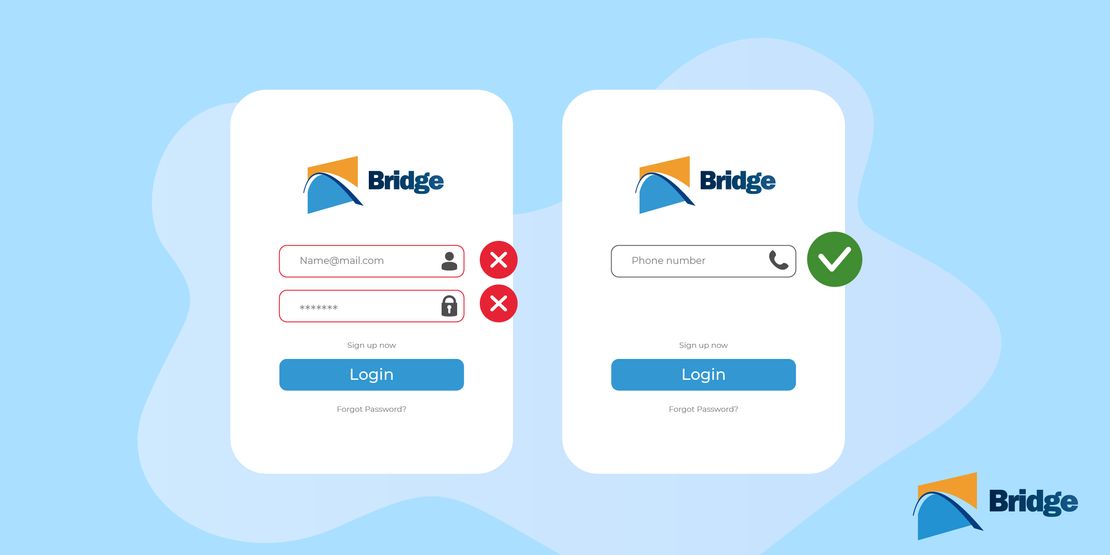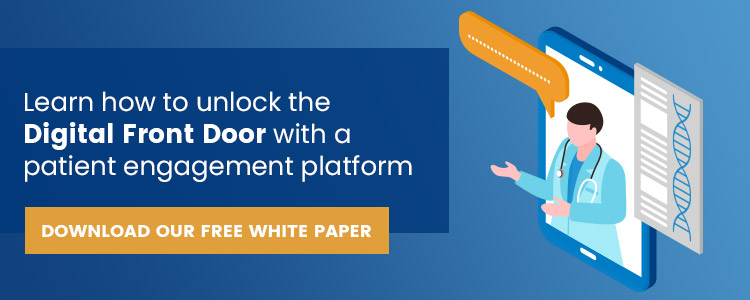Streamlining The Healthcare Experience With Passwordless Logins
- Kortney Orueta
- October 27, 2023

In today’s rapidly advancing digital age, managing sensitive healthcare information rests on two pillars that can sometimes seem at odds with each other—security and convenience. BridgeInteract understands the importance of this balance, which is why we have incorporated passwordless logins using face recognition and phone number logins into our suite of patient engagement apps. This innovative feature not only simplifies the user experience but also enhances security and streamlines patient intake, making it easier than ever for patients to access and manage their health information.
Problems With Passwords
Patients have a legal right to access their healthcare information electronically, but this sensitive data is also required to be secured according to standards set out in the 21st Century Cures Act. BridgeInteract’s patient access technology is based on meeting and exceeding these standards when it comes to security while also offering patients an easy and satisfying user experience.
Passwords have long been the go-to method for securing online accounts. However, they come with their own set of challenges, especially in the healthcare industry. Patients often have multiple accounts with different healthcare providers, each requiring a unique username and password—not to mention the additional mental load of remembering their logins to streaming services, rideshare apps, banking services, online shopping, and the other secure online applications that form part of modern life. As a result, patients are forced to remember a multitude of credentials, which can lead to forgetfulness, confusion, and the subsequent frustration of account lockouts and password resets.
Moreover, traditional passwords are vulnerable to various security threats, including brute force attacks and data breaches. Patients’ personal and medical information is extremely sensitive, making it imperative to safeguard it adequately. When it comes to patient-facing healthcare technology, doubts about security and issues logging on consistently crop up as barriers to patient engagement and satisfaction¹ ².
The Solution: Passwordless Logins
BridgeInteract has addressed these issues by introducing passwordless logins to our suite of patient engagement tools, including Bridge Intake. To benefit from the many advantages a patient engagement app can bring to your practice, it’s important to make the user experience as smooth as possible. Using passwordless logins, patients can access their healthcare information quickly, securely, and without the burden of memorizing yet another password.
BridgeInteract currently offers two options for passwordless logins, giving patients the option of choosing the best method for them. When using Bridge Intake, users can access their data using either:
- Face recognition
- Phone number + code sent to phone
Face Recognition
Face recognition offers a multitude of benefits as a login method, including:
- Unique ID: Face recognition enhances security significantly by using every user’s unique facial features for identification, reducing the risk of unauthorized access to sensitive medical data.
- Always on hand: Your face is always with you, making it a reliable and convenient way to verify your identity.
- Easy-to-use: Access by pointing a phone camera at your face is simple and easier to use than typing a password, especially on the go and for patients who may have conditions that affect their fingers. This not only simplifies the user experience but also mitigates the need for complex password management, reducing the likelihood of account lockouts.
Phone Number Login
Using this method, patients can use something that they are likely to know and use every day—their phone number. Here’s how it works:
- Upon opening the app, patients select the “Login with Phone Number” button to start the process.
- Patients enter their phone number.
- If the provided phone number matches our records, a secure verification code is sent to the patient’s phone for authentication.
For security reasons, patients have three attempts to enter the correct verification code. After three unsuccessful attempts, they will be temporarily blocked from using this feature for the day.
Proxy Accounts
The practice of sharing account credentials with caregivers and family members is common in healthcare, which makes it important to include an additional layer of verification to check if the user is the patient or a proxy³.
BridgeInteract fully supports face recognition and phone number access for proxy accounts. In cases where a phone number is associated with multiple accounts, the system prompts the user to enter the patient’s date of birth (DOB) before the verification code is sent. If more than one patient has the same DOB, the user will be requested also to enter their first name.

Benefits of Passwordless Logins
Enhanced Security:
Passwordless logins significantly enhance security. Instead of relying on a password that can be forgotten, stolen, or guessed, the system uses something the specific user always knows (e.g., their phone number) or has (e.g., their face, their smartphone) to ensure that only authorized individuals can access the account. This extra layer of security helps protect against unauthorized access and data breaches.
Streamlined User Experience:
One of the key advantages of passwordless logins is the seamless user experience it offers. Patients no longer need to rack their brains to remember complex passwords or worry about resetting forgotten credentials. This is especially beneficial for elderly patients who often find traditional password management challenging⁴. By eliminating the need for manual data entry, this streamlined approach improves user satisfaction and promotes the continued use of the app.
Reduced Administrative Burden:
In addition to benefiting patients, passwordless logins also make life easier for healthcare providers and administrators. Traditional password-related issues, such as forgotten passwords and account lockouts, can consume significant resources in terms of support requests and administrative work. By implementing passwordless logins, BridgeInteract reduces this administrative burden, allowing healthcare providers to focus on more critical aspects of patient care.
Future-Proofed:
BridgeInteract is committed to staying ahead of the curve when it comes to security. Passwordless logins provide a robust defense against evolving cybersecurity threats. With traditional passwords becoming increasingly vulnerable to advanced attacks, the use of 2FA and unique login codes ensures that patient data remains safe and secure.
Choose Safe, Secure, And Simple Data Access With BridgeInteract
BridgeInteract’s incorporation of passwordless logins is born from our commitment to both security and user experience. This feature benefits patients by offering a hassle-free and secure way to access their healthcare information, eases the administrative burden on healthcare providers, and protects healthcare organizations from cyberattacks.
In a world where digital healthcare is becoming increasingly prevalent, trust and security are paramount. With BridgeInteract’s passwordless logins, patients can have confidence in their healthcare provider’s commitment to safeguarding their sensitive information while enjoying a more user-friendly experience.
“Bridge has made a number of wonderful feature changes with the user interface recently that have improved the ease of use for patients.” – Noran Neurology
BridgeInteract sets a new standard for patient engagement, making healthcare management more accessible, secure, and efficient than ever before. Say goodbye to the hassle of traditional passwords and embrace the future of healthcare access with BridgeInteract.
Resources:
- Sorondo, B., Allen, A., Bayleran, J., Doore, S., Fathima, S., Sabbagh, I., & Newcomb, L. (2016). Using a Patient Portal to Transmit Patient Reported Health Information into the Electronic Record: Workflow Implications and User Experience. EGEMs, 4(3). Link. Accessed October 20, 2023.
- Yin R, Law K, Neyens D. Examining How Internet Users Trust and Access Electronic Health Record Patient Portals: Survey Study. (2021). JMIR Hum Factors, 8(3):e28501. Link. Accessed October 20, 2023.
- Latulipe C, Mazumder SF, Wilson RKW, et al. (2020) Security and Privacy Risks Associated With Adult Patient Portal Accounts in US Hospitals. JAMA Intern Med, 180(6):845–849. Link. Accessed October 20, 2023.
- Son, Hyojin MSN, RN; Nahm, Eun-Shim PhD, RN, FAAN. (2019). Older Adults’ Experience Using Patient Portals in Communities: Challenges and Opportunities. CIN: Computers, Informatics, Nursing 37(1):p 4-10. Link. Accessed October 20, 2023.